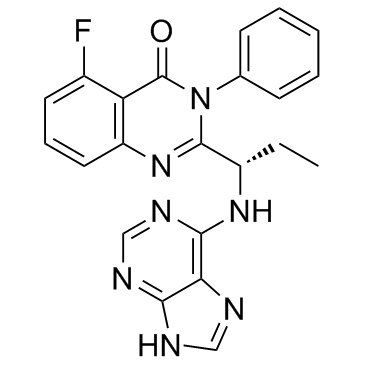870281-82-6
| Name | Idelalisib |
|---|---|
| Synonyms |
Zydelig
4(3H)-Quinazolinone, 5-fluoro-3-phenyl-2-[(1S)-1-(1H-purin-6-ylamino)propyl]- CAL-101 5-Fluoro-3-phenyl-2-[(1S)-1-(1H-purin-6-ylamino)propyl]-4(3H)-quinazolinone 4(3H)-Quinazolinone,5-fluoro-3-phenyl-2-[(1S)-1-(9H-purin-6-ylamino)propyl]- 5-Fluoro-3-phenyl-2-[(1S)-1-(9H-purin-6-ylamino)propyl]-4(3H)-quinazolinone Idelalisib GS-1101 CAL101 |
| Description | Idelalisib (CAL-101) is a highly selective and potent p110δ inhibitor with an IC50 of 2.5 nM, showing 40- to 300-fold selectivity for p110δ over other PI3K class I enzymes. |
|---|---|
| Related Catalog | |
| Target |
p110α:820 nM (IC50) p110β:565 nM (IC50) p110γ:89 nM (IC50) p110δ:2.5 nM (IC50) hVps34:978 nM (IC50) DNA-PK:6729 nM (IC50) |
| In Vitro | Idelalisib (CAL-101) is a highly selective and potent p110δ inhibitor (EC50=8 nM). Greater selectivity (400- to 4000-fold) is seen against related kinases C2β, hVPS34, DNA-PK, and mTOR, whereas no activity is observed against a panel of 402 diverse kinases at 10 μM. CAL-101 reduces PDGF-induced pAkt by only 25% at 10 μM. Idelalisib (CAL-101) inhibits LPA-induced pAkt with an EC50 of 1.9 μM. Idelalisib (CAL-101) blocks FcϵRI p110δ-mediated CD63 expression with an EC50 of 8 nM, whereas formyl-methionyl-leucyl-phenylalanine activation of p110γ is inhibited with an EC50 of 3 μM. Thus, in cell-based assays, CAL-101 has 240- to 2500-fold selectivity for p110δ over the other class I PI3K isoforms[1]. CAL-101Idelalisib (CAL-101)-induced apoptosis of chronic lymphocytic leukemia (CLL) cells is significant compare with vehicle treatment alone (P<0.001). Idelalisib (CAL-101) induces selective cytotoxicity in CLL cells independent of IgVH mutational status or interphase cytogenetics[2]. |
| In Vivo | A significant reduction is observed in the CD11b+Ly6G+ neutrophils from brain homogenates of bothp110δD910A/D910A mice and Idelalisib (CAL-101) (40 mg/kg, i.v.) post-treated mice[3]. |
| Cell Assay | MTT assays are performed to determine cytotoxicity. Briefly, 1×105 cells (CLL B cells or healthy volunteer T cells or NK cells) are incubated for 48 hours with different concentrations of Idelalisib (CAL-101) (0.1 μM, 1 μM, 5 μM, 10 μM), 25 μM LY294002, or vehicle control. MTT reagent is then added, and plates are incubated for an additional 20 hours before washing with protamine sulfate in phosphate-buffered saline. DMSO is added, and absorbance is measured by spectrophotometry at 540 nm in a Labsystems plate reader. Cell viability is also measured at various time points with the use of annexin/PI flow cytometry. Data are analyzed with Expo-ADC32 software package. At least 10,000 cells are counted for each sample. Results are expressed as the percentage of total positive cells over untreated control. Experiments examining caspase-dependent apoptosis included the addition of 100 μM Z-VAD. Experiments examining survival signals include the addition of 1 μg/mL CD40L, 800 U/mL IL-4, 50 ng/mL BAFF, 20 ng/mL TNF-α, or coculturing on fibronectin or stromal (HS-5 cell line) coated plates. Stromal coculture is done by plating a 75-cm2 flask (80%-100% confluent) per 6-well plate 24 hours before the addition of CLL cells[2]. |
| Animal Admin | Mice[3] For Idelalisib (CAL-101) treatment, wild-type C57BL/6 mice are administered either 40 mg/kg Idelalisib (CAL-101) or vehicle DMSO, by 25 μL infusion into the femoral vein, 15 min before I/R (pre-treatment), or 3 and 6 h after initiation of reperfusion (post-treatment). Controls and animals treated with Idelalisib (CAL-101) underwent cerebral blood flow (CBF) measurements using a laser Doppler perfusion monitor. The CBF measurements obtained immediately before and after MCAO and again at 3 h after reperfusion showed an ~90-95% reduction in the blood flow to the MCAO infarct region, which does not differ between groups. |
| References |
| Density | 1.5±0.1 g/cm3 |
|---|---|
| Molecular Formula | C22H18FN7O |
| Molecular Weight | 415.423 |
| Exact Mass | 415.155701 |
| PSA | 101.38000 |
| LogP | 2.96 |
| Index of Refraction | 1.741 |

